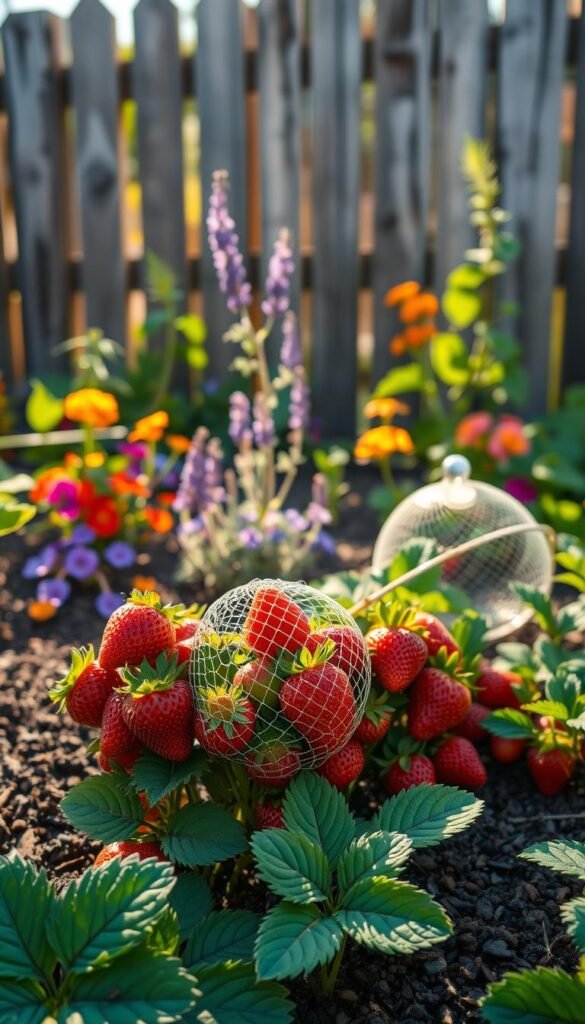Nothing beats biting into juicy, homegrown fruit bursting with flavor. But keeping your crops thriving requires more than just sunlight and water. Tiny invaders and plant diseases can quickly turn a vibrant patch into a struggling mess if left unchecked.
Many growers are discovering that working with nature’s rhythms yields better results than harsh sprays. Simple strategies like encouraging helpful insects or using plant-based treatments create balanced ecosystems. For example, introducing ladybugs – which devour up to 50 aphids daily – offers free and effective protection.
Healthy soil plays a starring role in prevention. Enriching earth with compost strengthens roots while deterring common fungal issues. Pairing your crops with pest-repelling companions like basil or chives adds another layer of defense. These methods prove especially useful for smaller spaces, as highlighted in our guide to eco-friendly pest control solutions.
This approach isn’t just about avoiding chemicals. It’s about cultivating resilient plants that naturally resist threats. You’ll learn how neem oil tackles multiple problems at once and why early intervention saves entire harvests. Let’s explore how to create a flourishing environment where your favorite fruits thrive season after season.
Welcome to Your Strawberry Garden

There’s something magical about stepping into your own lush patch of sweetness each morning. Beyond the joy of fresh-picked treats, this space becomes a living classroom where soil, sunlight, and care converge to create something extraordinary.
Benefits of a Thriving Patch
Vibrant crops reward you with multiple harvests from spring through fall. Imagine plucking sun-warmed gems for summer desserts or freezing extras for winter smoothies. Healthy plants also support local ecosystems by sheltering pollinators and improving soil structure naturally.
“A well-tended patch gives back tenfold,” says veteran grower Marie Kellett. “It’s where science meets wonder.” You’ll notice fewer grocery runs and more moments sharing nature’s bounty with loved ones.
Understanding Common Challenges
Even robust crops face threats. Tiny invaders like aphids can cluster under leaves, while spider mites leave telltale webbing. Fungal issues often start as discolored spots before spreading rapidly in humid conditions.
Early detection is key. For instance, gray mold first appears as fuzzy patches on blossoms. By catching these signs quickly, you can use solutions from organic pest control for beginners before damage escalates. Regular checks let you protect your hard work while keeping chemicals off your plate.
Understanding Strawberry Plant Vulnerabilities
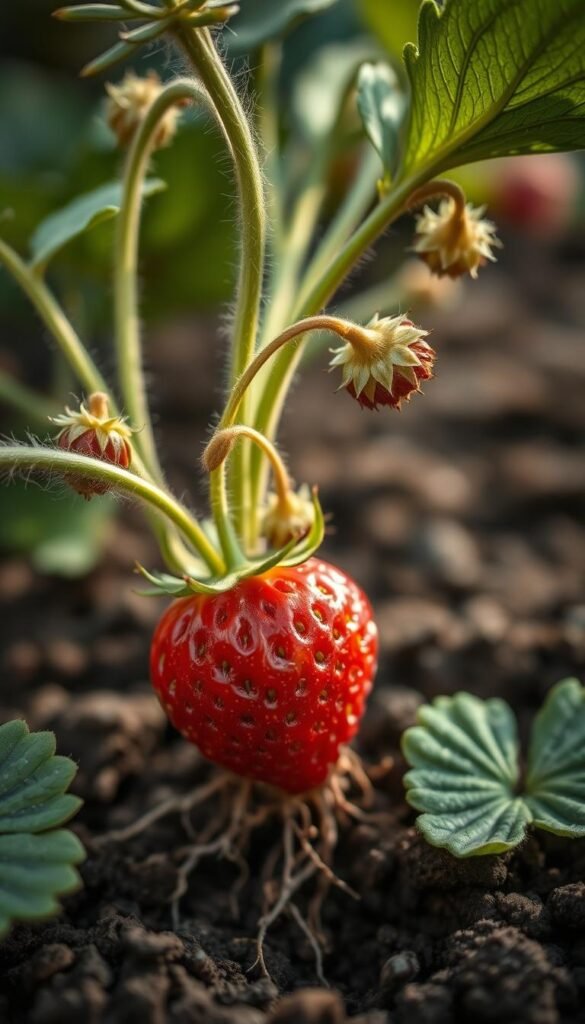
Healthy growth starts with knowing where your plants need extra support. Like any living system, these perennials have specific weak spots that demand attention. Recognizing these areas helps you create targeted defenses against threats.
Key Plant Anatomy and Weak Points
Your plant’s crown – the thick center where stems emerge – acts as its vital hub. When debris collects here or soil drainage falters, rot can set in quickly. Young leaves and developing fruit attract the most pests due to their tender texture.
Watch for curled edges or stippling on leaves, early signs of sap-sucking insects. Flowers often show first symptoms of fungal issues like gray mold. Regular checks of these areas let you intervene before damage spreads.
Environmental Influences on Plant Health
Humidity turns your patch into a breeding ground for leaf blight when air circulation falters. Temperature swings stress plants, making them less resistant to invaders. Did you know? Spider mites thrive in dry heat, while slugs multiply after heavy rains.
Soil quality directly impacts root strength and nutrient uptake. Compact earth or poor pH balance weakens plants from below. By monitoring local weather patterns and adjusting care routines, you create conditions where your crops naturally resist problems.
Strawberry Garden Pest Control: Natural Ways to Protect Your Berries
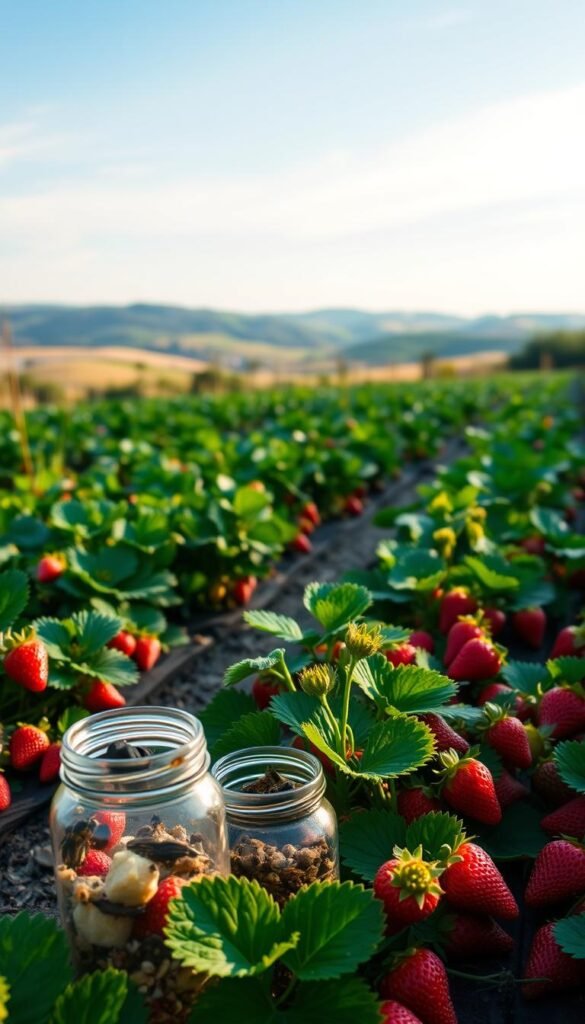
Embracing organic methods fosters a healthier growing space where plants and wildlife thrive together. These strategies protect your harvest while maintaining nature’s delicate balance, creating a self-sustaining environment that benefits everyone – including your taste buds.
Why Choose Organic Methods?
Chemical-free solutions keep your snacks safe to eat right off the plant. Neem oil disrupts harmful insects’ life cycles without leaving toxic residues, while insecticidal soap washes away soft-bodied bugs like aphids. These targeted treatments spare pollinators and soil microbes crucial for plant health.
You’ll save money over time by working with nature’s existing systems. Ladybugs devour up to 50 aphids daily, providing free organic insect management. Sticky traps catch flying pests before they lay eggs, reducing future infestations naturally.
Organic approaches also prevent pests from developing resistance – a common issue with synthetic sprays. By rotating prevention methods and encouraging predator habitats, you create lasting control that adapts as your garden grows. Your strawberry plants become hardier, producing sweeter fruit season after season.
Identifying Common Pests and Their Damage
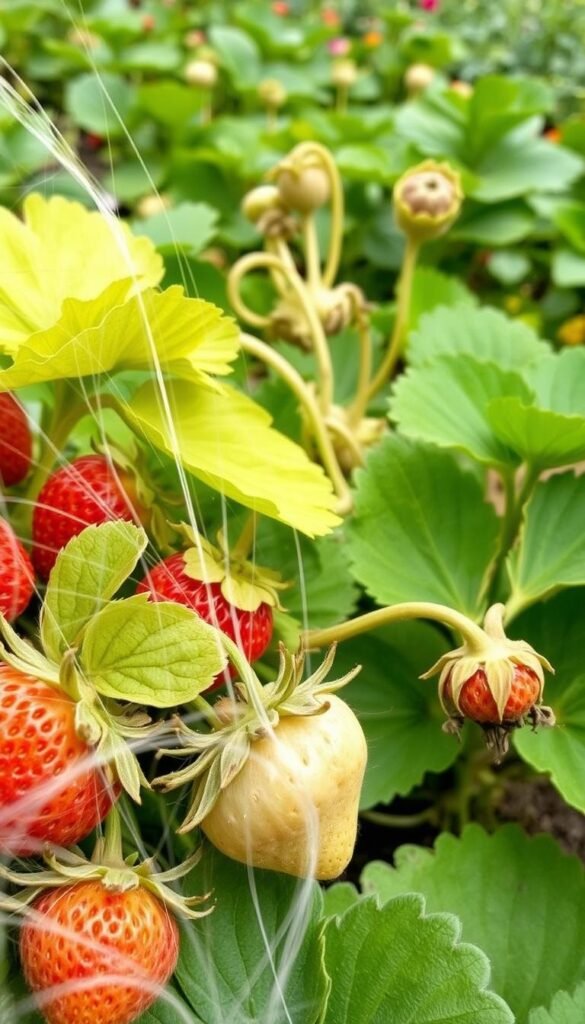
Spotting trouble early keeps your sweet harvests safe and sound. Four frequent offenders leave distinct calling cards on plants. Learning their signatures helps you respond before they throw a feast at your expense.
Recognizing Aphids, Spider Mites, and More
Tarnished plant bugs wear yellow-brown jackets with black dots or red stripes. These winged adults inject toxins that create sunken fruit dimples and stunt new growth. Aphids prefer stealth mode – check stem joints and leaf undersides for their pear-shaped squads.
| Pest | Appearance | Damage Signs | Plant Area |
|---|---|---|---|
| Tarnished Bug | Yellow-brown with spots | Sunken fruit, dwarfed shoots | Fruit & stems |
| Aphids | Pinhead-sized clusters | Curled yellow leaves | Stems & undersides |
| Spider Mites | Reddish specks with webbing | Stippled leaf spots | Leaf surfaces |
| Leaf Beetles | Shiny black adults | Lace-like holes | Foliage & roots |
Damage Patterns and Early Warning Signs
Spider mites paint leaves with yellow confetti before turning them bronze. Their delicate webs often go unnoticed until populations explode. Beetle larvae work underground like tiny saboteurs, attacking roots while adults punch holes overhead.
Watch for:
- Sticky honeydew residue (aphid parties)
- White cast skins near leaf veins (mite molts)
- Notched leaf edges (adult beetles snacking)
“Daily walks through your patch become detective work. The plants whisper clues if you know how to listen.”
Track changes in a notebook – early leaf discoloration or slowed growth often precede visible bugs. Healthy plants rebound faster when you catch these stealthy diners before they invite friends.
Natural Methods for Managing Fungal Diseases
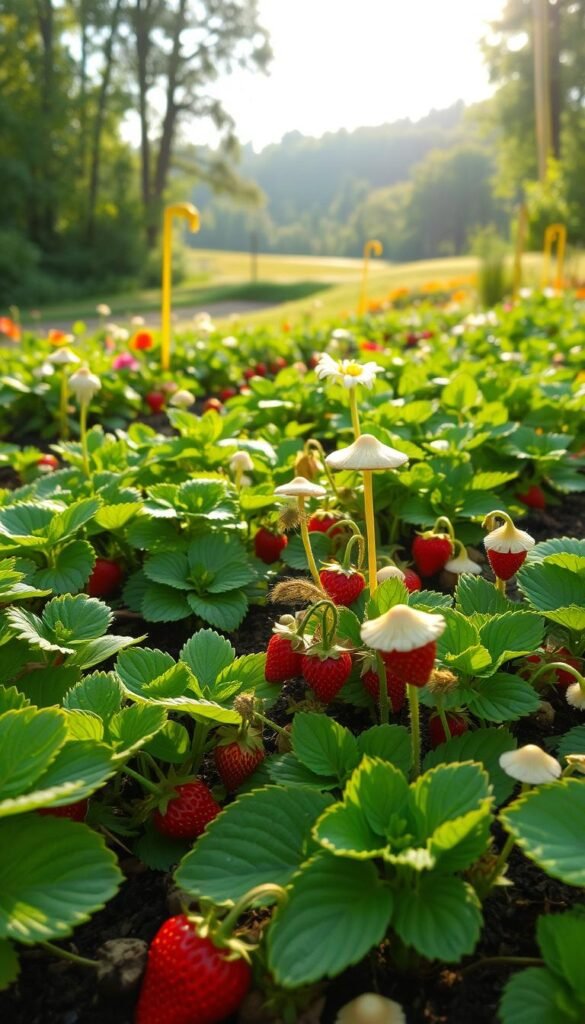
Healthy fruit starts with smart defense strategies against stealthy fungal threats. These unwelcome guests love damp leaves and crowded spaces, but you can outsmart them with simple adjustments to your care routine.
Organic Fungicide Solutions
When moisture lingers too long, gray mold coats berries in fuzzy gray jackets. Potassium bicarbonate becomes your ally here – mix 1 tablespoon per gallon of water and spray leaves weekly during humid spells. For leaf spot’s purple bullseyes, copper-based formulas create protective barriers without harming soil life.
| Disease | Signs | Prevention | Treatment |
|---|---|---|---|
| Gray Mold | Fuzzy spores on fruit | 6-inch plant spacing | Neem oil spray |
| Powdery Mildew | White leaf powder | Morning watering | Baking soda mix |
| Leaf Spot | Purple-brown circles | Remove debris weekly | Copper fungicide |
Cultural Practices to Prevent Fungal Spread
Smart watering makes all the difference. Use drip lines or water at soil level before noon – this gives leaves time to dry completely. Rotate your crops every 3 years to disrupt disease cycles naturally.
“Fungi can’t thrive where sunlight dances freely between plants.”
Three key habits protect your plants:
- Clear fallen leaves and spent blooms daily
- Disinfect tools after touching diseased areas
- Mulch with straw to prevent soil splashback
Combine these methods with integrated disease management approaches for best results. Pair organic sprays with organic garden care strategies to create multiple defense layers against fungal invaders.
Utilizing Natural Predators in Your Garden
Nature provides its own security team when you know how to recruit it. By fostering habitats for helpful insects, you turn your growing area into a self-regulating sanctuary. This approach works like a neighborhood watch program – predators patrol your plants while you enjoy the results.
Attracting Beneficial Insects
Ladybugs aren’t the only heroes on duty. Lacewings snack on aphids, while hoverflies target thrips. Plant nectar-rich flowers like marigolds or yarrow near your crops – these act as welcome signs for adult predators. They’ll stick around to lay eggs where pests gather, creating a renewable defense force.
Diversity matters more than perfection. Letting some areas grow wild offers shelter for ground beetles that hunt slugs. A shallow dish with stones and water becomes a drinking station for thirsty allies. Over time, these small changes build a balanced ecosystem where pests rarely gain the upper hand.
Remember: predator populations need time to flourish. Avoid reaching for sprays – even organic ones – during their establishment phase. Within a few seasons, you’ll notice fewer damaged leaves and healthier strawberry harvests as nature’s workforce takes charge.

